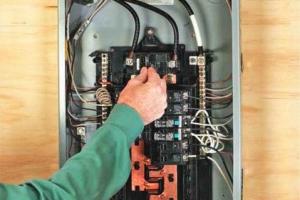Step-by-Step Guide on How to Install a Transfer Switch for Your Home

-
Quick Links:
- Introduction
- What is a Transfer Switch?
- Why You Need a Transfer Switch
- Types of Transfer Switches
- Tools and Materials Needed
- Safety Considerations
- Step-by-Step Installation Guide
- Common Mistakes to Avoid
- Case Studies
- Expert Insights
- Conclusion
- FAQs
Introduction
Power outages can be not only inconvenient but also dangerous. Whether due to severe weather, equipment failure, or other unforeseen events, having a reliable backup power source is essential for any homeowner. One of the best ways to ensure that you can safely and effectively use your backup generator is by installing a transfer switch. This comprehensive guide will walk you through the intricacies of installing a transfer switch, ensuring that you can confidently tackle this project.
What is a Transfer Switch?
A transfer switch is an electrical device that enables the safe connection of a portable generator to your home’s electrical system. It allows you to switch between utility power and generator power safely, preventing back-feeding electricity into the grid, which can endanger utility workers and damage your generator.
Why You Need a Transfer Switch
- Safety: Prevents back-feeding and electrical hazards.
- Convenience: Easily switch between power sources.
- Compliance: Meets local electrical codes.
- Protection: Safeguards appliances and home systems.
Types of Transfer Switches
There are primarily two types of transfer switches:
- Manual Transfer Switch: Requires manual operation to switch between power sources.
- Automatic Transfer Switch: Automatically switches to generator power during an outage.
Tools and Materials Needed
Before you begin, gather the following tools and materials:
- Transfer switch kit
- Wire cutters and strippers
- Drill
- Screwdriver set
- Voltage tester
- Safety goggles and gloves
Safety Considerations
When working with electricity, safety is paramount. Ensure you:
- Turn off the main power supply.
- Wear appropriate safety gear.
- Follow local electrical codes.
- Consult a licensed electrician if unsure.
Step-by-Step Installation Guide
Follow these steps for a successful installation of your transfer switch:
Step 1: Plan Your Installation
Identify which circuits you want to power during an outage and plan your installation accordingly.
Step 2: Install the Transfer Switch
- Mount the transfer switch on the wall near your main electrical panel.
- Connect the switch to the selected circuits.
- Ensure all connections are secure.
Step 3: Connect to the Generator
Follow the manufacturer's instructions to connect the transfer switch to your generator using the appropriate cables.
Step 4: Test the System
After installation, conduct a test run to ensure everything functions correctly.
Common Mistakes to Avoid
- Not adhering to local codes and regulations.
- Improperly sizing the transfer switch.
- Neglecting to test the system after installation.
Case Studies
Case Study 1: A Family’s Experience with Power Outages
A family in Florida installed a transfer switch after experiencing frequent outages due to hurricanes. They reported feeling more secure during storms, knowing they could power essential appliances safely.
Case Study 2: Commercial Use of a Transfer Switch
A local business installed an automatic transfer switch to ensure their operations could continue during outages, leading to minimal downtime and increased customer satisfaction.
Expert Insights
Electrical experts emphasize the importance of proper installation techniques and the necessity of consulting with professionals for complex systems. Regular maintenance and testing are also crucial to ensure reliability.
Conclusion
Installing a transfer switch is a vital step in preparing for power outages, ensuring safety and convenience. By following this guide, you can confidently install your transfer switch and enjoy peace of mind during unforeseen circumstances.
FAQs
1. What is the cost of installing a transfer switch?
The cost can vary widely but expect to spend between $300 to $1,000, depending on the type and complexity.
2. Can I install a transfer switch myself?
Yes, but ensure you have a good understanding of electrical systems. If in doubt, consult a licensed electrician.
3. How do I choose the right transfer switch?
Consider the wattage of your generator and the circuits you wish to power.
4. Are there permits required for installation?
Typically, yes. Check with your local building authority.
5. What is the difference between a manual and an automatic transfer switch?
A manual switch requires you to switch power sources manually; an automatic switch does this automatically during an outage.
6. How often should I test my transfer switch?
It is recommended to test it at least once every six months.
7. What appliances can I power with a transfer switch?
You can power essential appliances like refrigerators, heaters, and medical devices, depending on your generator's capacity.
8. Can I use a transfer switch with a solar generator?
Yes, but ensure compatibility and follow proper installation guidelines.
9. What happens if I don’t have a transfer switch during an outage?
Without one, you risk damaging your generator and creating hazardous conditions.
10. Can I install a transfer switch outside?
Some transfer switches are designed for outdoor use; check the specifications before installation.
For more information on electrical safety and best practices, consider visiting NFPA Education and USA.gov Electrical Safety.
Random Reads